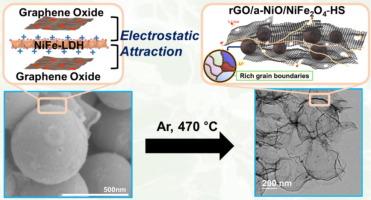Phase change-induced heterointerface engineering of hollow sphere structured graphene oxide/layered double hydroxide composites for superior pseudocapacitive energy storage in lithium-ion batteries
IF 13.3
1区 工程技术
Q1 ENGINEERING, CHEMICAL
引用次数: 0
Abstract
Integrating transition metal oxides with carbon-based materials through chemical heterointerface engineering presents a promising approach for achieving enhanced ionic/electrical conductivity, additional interfacial storage space, and structural stability, facilitating superior cyclic performance in energy storage systems. In this study, we synthesized a hierarchical heterostructure composite by combining graphene oxide with nickel–iron layered double hydroxides and promoted the formation of additional grain boundaries through phase change. Thus, we enhanced the pseudocapacitive contributions and the ion/charge transfer kinetics through nano-interfaces. These hybrid structures were formed through the layer-by-layer self-assembly of two-dimensional nanosheets. This design facilitates the construction of low-dimensional nanoarchitecture suitable for long-term cycling without ionic intermediates. Furthermore, to prevent agglomeration during the annealing process, we induced a phase change in NiCo-LDH under an inert atmosphere to fabricate reduced graphene oxide (rGO) embedded with amorphous nickel oxide (a-NiO) and NiFe2O4 nanoparticles, designated as rGO/a-NiO/NiFe2O4-HS. When utilized as an anode material for lithium-ion batteries, this material maintained an outstanding specific capacity of 1687.6 mA h/g at a current density of 100 mA g−1 after 580 cycles. This nanostructuring and phase change strategy of the two-dimensional heterostructures can effectively promote the development of high-performance electrode materials based on the pseudocapacitive mechanism.

求助全文
约1分钟内获得全文
求助全文
来源期刊

Chemical Engineering Journal
工程技术-工程:化工
CiteScore
21.70
自引率
9.30%
发文量
6781
审稿时长
2.4 months
期刊介绍:
The Chemical Engineering Journal is an international research journal that invites contributions of original and novel fundamental research. It aims to provide an international platform for presenting original fundamental research, interpretative reviews, and discussions on new developments in chemical engineering. The journal welcomes papers that describe novel theory and its practical application, as well as those that demonstrate the transfer of techniques from other disciplines. It also welcomes reports on carefully conducted experimental work that is soundly interpreted. The main focus of the journal is on original and rigorous research results that have broad significance. The Catalysis section within the Chemical Engineering Journal focuses specifically on Experimental and Theoretical studies in the fields of heterogeneous catalysis, molecular catalysis, and biocatalysis. These studies have industrial impact on various sectors such as chemicals, energy, materials, foods, healthcare, and environmental protection.
 求助内容:
求助内容: 应助结果提醒方式:
应助结果提醒方式:


